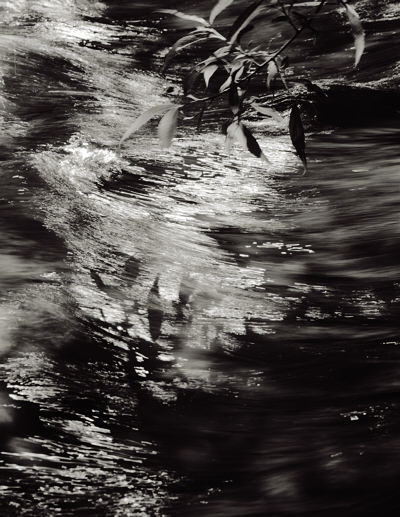
Dapples are difficult wherever they are. Lately, I’ve been trying to catch shadows on a stream, without great success. But according to Hopkins, we should be grateful nonetheless:
“Pied Beauty” (1877)
Gerard Manley HopkinsGlory be to God for dappled things–
For skies of couple-colour as a brinded cow;
For rose-moles all in stipple upon trout that swim;
Fresh-firecoal chestnut-falls; finches’ wings;
Landscape plotted and pieced–fold, fallow, and plough;
And áll trádes, their gear and tackle and trim.
All things counter, original, spare, strange;
Whatever is fickle, freckled (who knows how?)
With swift, slow; sweet, sour; adazzle, dim;
He fathers-forth whose beauty is past change: Praise Him.

Steve:
You sir are a dappleganger, so alike are we in our regard for the mottled.
I remember well your trout and also your implacable, deadpan boulders, and how the one is a complete success and the others wanting for a completion.
There are times when I would rather sit by the pool and contemplate the wavering optical effects, created by the junction of wave and light, than to jump in. I’m looking at a phenomenon that can be described and modeled precisely, given a computer the size of the pool itself, but which is deeply spiritual in its effect on me.
And to think that there is a popular misconception that a Manley man cannot be sensitive.
A gang of dabblers might be closer the mark.
Steve:
I chortle.
Steve:
But mottle citizens all the same.
Steve,
Only yesterday, Troels told me to let you know how much he is enjoying your print of the Cutthroat, Trout Lake, Yellowstone.
It must be much harder to catch shadows on a stream in b+w.
I enjoyed the poem after I googled the meaning of pied. Immigrants!
I, too, have been trying to capture shadows/reflections on water. For some reason I find that cropping square helps my composition. I wonder if you think this helps your images; it would be interesting to see if there is something about water that benefits from that format.
I like the pic in this post a lot and would like to see more like it. Peace/Mike
Mike,
I also find the square format terrific, and I did all of my original Sourdough Trail series in that way. I think this one works well square, if you take mostly from the bottom, but I decided for some reason to do less than that for now.
I don’t believe it’s anything special about water as subject that makes a square format attractive. Actually, given the freedom of where to crop, I think trying almost any shape can potentially bring out interesting things. What I like about square is the absence of a dominant axis.
Mike, I really liked your illness:recovery portfolio. Excellent concept and photographs!
Mike, I really like your water pictures, particularly the ones in color, in The Bleak and the Beautiful and After the Thaw.
Mike, hi,
Let me add my “wow” as well. Beautifully thought about and beautifully done.
Thanks for your kind words. I’m glad to find someone whose work I like that is in the same vane as mine.
-Mike
Steve:
I would be remiss if I didn’t add my own comment of appreciation concerning your image of the water. I like the way that it swings, pendulum-like, from the leafy branch above. In the water there is a most intriguing reflection of a leaf. Did you add that?
Jay, I’m shocked you could think it of me! That’s actually a shadow on the water, sharp because of the nearness of that set of leaves. I’m still trying to photograph those shadows, but it’s been tough to deal with the combination of moving water, bright glare, and composition of all the elements. Sooner or later, I hope to present a better one.
Steve:
The improbability, to my eye, of the various relationships therein, makes this most intriguing.
It is odd, which is partly why it intrigued me. The leaves appear to be above the shadow, but they’re actually a bit farther out across the stream, and the sun is behind them.
Interestingly, the distinction between a shadow and a reflection becomes, if I might say so, blurred in this situation. The bright areas around the shadow/reflection are essentially specular reflection of the sun. Without getting too heavily into the optics, the difference is that a shadow would be sharpest when focused on the surface of the water (where the shadow falls), whereas a reflection would be sharpest when focusing beyond that point to where the leaf is located (i.e. at the distance traveled by a light ray from the leaf reflecting off the water). It surprised me that, though not really evident from this image, the sharpest image was when focused on the water.